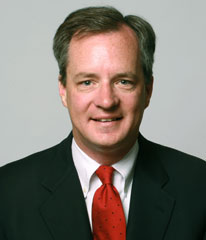
Few know more about the legendary economist and his impact on economic thought than Steven Medema. He is the author of many books and scholarly articles on the history of twentieth-century economics, with an emphasis on the work of Ronald Coase. His latest book, The Hesitant Hand: Taming Self-Interest in the History of Economic Ideas, was awarded the 2010 Book Prize by the European Society for the History of Economic Thought.
Medema is a professor of economics at the University of Colorado Denver and a 2011 PERC Lone Mountain fellow. For more of PERC’s Q&As, see the series archive.
Q: Ronald Coase’s 1960 article on “The Problem of Social Cost” had a tremendous impact on economics, including PERC’s work on free market environmentalism. What is the “Coase theorem” and how has it evolved in economic thought?
A: The Coase theorem tells us that if property rights over the relevant resources are well-defined and the costs of transacting are zero, parties who disagree over the use of those resources will negotiate to an efficient solution, regardless of to whom the property rights are assigned. The upshot of the theorem is that private negotiations or other market-like processes can efficiently resolve social cost (“externality”) problems such as those associated with air and water pollution. Of course, transaction costs are never zero, and much of the discussion of the theorem over the years has attempted to work out the possibilities and limitations of negotiated solutions when transaction costs are positive. Though much of the early reaction to the theorem was negative, the discussion has evolved into one that focuses somewhat less on the theorem per se (that is, with its highly restrictive assumptions) and somewhat more on departures from these conditions and how Coase-theorem-like processes may be operative under more realistic conditions.
Q: Over the years, people have come to refer to a hypothetical world of zero transaction costs as a “Coasian world.” Is this view accurate?
A: Those who refer to such a world haven’t read Coase very closely. The world of zero transaction costs is a fiction—but a sometimes useful fiction, not unlike a vacuum in physics. It was also a bedrock assumption of mainstream economics for ages, including of the economics against which Coase was reacting in “The Problem of Social Cost.” What Coase showed was that, in the world of neoclassical economics, government regulation was unnecessary for an efficient resolution of social cost problems. If property rights are assigned over the resources in question and there are no costs of transacting, the parties will efficiently resolve the problem through negotiation. So, Pigovian remedies are unnecessary in a Pigovian (costless transacting) world. But Coase’s emphasis was on the fact that the costs of transacting are not zero, and nor are the costs associated with government action to deal with social cost problems. The evaluation of how society should deal with such problems thus involves a comparison of the benefits and costs of alternative courses of action—including the possibility of allowing the problem to persist if the costs of “curing” it are worse than the disease itself.
Q: We hear a lot about the Coase theorem in environmental economics. How has the Coase theorem impacted discussions of environmental economics and environmental policy?
A: I think that its central impact has been in the way of making scholars—and later policy makers—aware of the possibility of using the exchange process to deal with social cost issues. Of course, the Coase theorem is an idealized construct that does not reflect the world in which we live. But by showing how property-rights-based solutions can generate private, efficiency-enhancing moves, the theorem opened the door to the subsequent analysis of exchange solutions in the real world, and thus to both theories and policies that employ such a framework.
Q: You suggest that the Coase theorem is widely recognized among environmental economists and taught in most textbooks, yet its relevance is often viewed as extremely limited. Why is this so? Why then are so many environmental economists interested in Coase?
A: My sense is that most environmental economists see Coase as important because he emphasized that social cost problems are ultimately problems related to incomplete property rights. This makes Coase’s analysis the natural starting point for the analysis of social cost issues. The rub comes in where one goes from there. Some continue to hew to what we might call a “Pigovian” line—emphasizing that regulatory mechanisms or taxes are necessary to correct the problem—while others are more interested in exploring whether markets or market-like mechanisms can be utilized to resolve the problem. But there is broad general agreement that social cost problems have their roots on the property rights side, and this viewpoint owes to Coase.
Q: Discussions of environmental economics often center around externalities. Coase avoids this term. How has Coase’s work influenced the way we think about external costs?
A: My sense is that, at a minimum, he impressed upon some that social cost problems, or externalities, are reciprocal in nature. One can view this in two ways. First, it takes two to tango. That is, if A is generating smoke that harms B, B may be said to be as much the “cause” of the harm as A, since B could mitigate damages by, e.g., moving away. Second, A may be imposing harm on B, but to restrain A’s activity in favor of B is to impose harm on A. Some see this as a “right-wing” sort of point, but it is not. It actually has a long history in jurisprudence and was held by none other than J.R. Commons, a prominent Institutionalist economist and Progressive in who worked during the first half of the twentieth century. But value judgments often get in the way of sound reasoning when it comes to things like externalities, so not everyone has gotten on board with Coase’s notion of reciprocity.
Q: Critics of Coase often contend that transaction costs in markets are too high for Coasian-type bargaining to occur: negotiations can be costly, multiple parties can be affected, and information is diffuse. This is no doubt often the case, yet transaction costs are also present in the political process. How do these costs affect the way we understand Coase’s relevancy to environmental policy?
A: If one adopts an efficiency-based perspective on these things, the point to be taken is that there is no such thing as a determinate optimal solution to social cost problems. One can only come to grips with these things on a case-by-case basis, weighing the benefits and costs associated with alternative courses of action and recognizing that both markets/exchange and government activity have associated with them certain costs—often substantial. Coase is not about the Coase theorem; he was a strong advocate of comparative institutional analysis and that, at a minimum, economic benefits and costs have an important role to play in evaluating policy options. With this came a great concern about the costs associated with government action—costs that he (rightly) believed had been underplayed or ignored in the theory and practice of social cost policy.
Q: Why are concerns about equity so prominent in environmental discussions of Coase?
A: Probably because Coase focused so heavily on efficiency. But there was good reason for this—it was the language in which the welfare economics of social cost issues had been discussed for a half-century. And as we all know, there are plenty of occasions when the dictates of efficiency collide with some people’s sense of what is “right.” The very possibility that the “victims” of pollution should bribe the factory owners to reduce their pollution levels is anathema to many. Interestingly, though, Coase talks about larger concerns (“aesthetics and morals”) toward the end of “The Problem of Social Cost.” But since most readers failed to pay attention to his arguments beyond the Coase theorem material (the first 15 pages of a 44-page article), they didn’t seem to notice this.
Q: What can we take away from Coase’s work and apply to the area of free market environmentalism?
A: I believe that there are two key insights. The first is that markets/exchange can work to resolve certain social cost issues. The question is which ones, and this can only emerge from careful and patient study. The second is that neither markets nor government are panaceas. Both generate imperfect solutions, and the question is that of which of these imperfect solutions is best for dealing with the problem at hand. This, too, can only be determined from careful and patient study. Unfortunately, too many economists and policy makers do not want to hear such things. But “create markets” or “we need government to solve the problem” takes us nowhere. These are difficult problems, and we seldom find that difficult problems have easy solutions.


